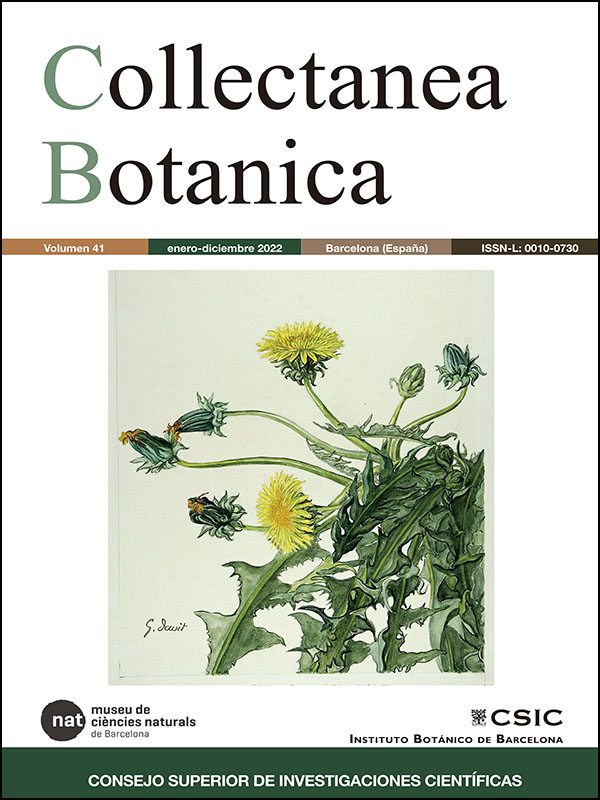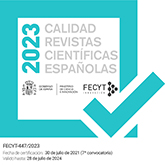Los marcadores microsatélite revelan la reestructuración genética de Medicago sinskiae (Fabaceae) en el oeste y el sudoeste de Irán
DOI:
https://doi.org/10.3989/collectbot.2022.v41.002Palabras clave:
genética de poblaciones, marcadores microsatélite, Medicago anualesResumen
Medicago sinskiae es considerada una especie rara en la flora iraní con únicamente unas pocas citas en las tres últimas décadas. Se han muestreado ocho poblaciones (62 individuos) de M. sinskiae, una población de M. rigidula (siete individuos) y una población de M. constricta (cinco individuos) en el oeste y el suroeste de Irán que han sido analizadas con marcadores microsatélite. Se han utilizado nuevos primers obtenidos con tecnología NGS. Los análisis de PCoA, Clustering y Structure no muestran un patrón geográfico para los clústeres genéticos. Los resultados muestran que M. sinskiae es principalmente una especie autógama. Se asume que los altos niveles de flujo genético (Nm) y la homogeneidad genética poblacional están afectados por una rápida dispersión y un flujo genético no localizado. Recolecciones extensivas realizadas recientemente en el oeste y el suroeste de Iran muestran que el rango de distribución esta especie se está incrementando. Finalmente, nuestros resultados indican que M. sinskiae está diferenciada de las especies M. rigidula y M. constricta en Irán.
Descargas
Citas
Bagheri, Z., Assadi, M., Small, E. & Mehregan, I. 2022. Cryptic molecular-geographical divergence within Medicago minima revealed by SSR markers. Iranian Journal of Science and Technology, Transactions A: Science 46: 49-60. https://doi.org/10.1007/s40995-021-01236-8
Barrett, S. C. H., Colautti, R. I. & Eckert, C. G. 2008. Plant reproductive system and evolution during biological invasion. Molecular Ecology 17: 373-383. https://doi.org/10.1111/j.1365-294X.2007.03503.x PMid:17868309
Bataillon, T. & Ronfort, J. 2006. Evolutionary and ecological genetics of Medicago truncatula. In: Mathesius, U., Journet, E. P. & Sumner, L. W. (Eds.), The Medicago truncatula handbook. Noble Research Institute, Ardmore: 1-13.
Bayat, M., Assadi, M., Small, E. & Mehregan, I. 2021. Molecular studies of Iranian populations support the morphology-based taxonomic separation of Medicago rigidula and M. rigiduloides. Phytotaxa 518: 281-299. https://doi.org/10.11646/phytotaxa.518.4.5
Bonnin, I., Ronfort, J., Wozniak, F. & Olivieri, I. 2001. Spatial effects and rare outcrossing events in Medicago truncatula (Fabaceae). Molecular Ecology 10: 1371-1383. https://doi.org/10.1046/j.1365-294X.2001.01278.x PMid:11412361
Burkil, A., Sieber, N., Seppala, K. & Jokela, J. 2017. Comparing direct and indirect selfing rate estimates: when are population-structure estimates reliable. Heredity 118: 525-533. https://doi.org/10.1038/hdy.2017.1 PMid:28177324 PMCid:PMC5436024
Chabane, K., Varshney, R. K., Graner, A. & Valkoun, J. 2008. Generation and exploitation of EST-derived SSR markers for assaying molecular diversity in durum wheat populations. Genetic Resources and Crop Evolution 55: 869-881. https://doi.org/10.1007/s10722-007-9292-8
Dakin, E. & Avise, J. 2004. Microsatellite null alleles in parentage analysis. Heredity 93: 504-509. https://doi.org/10.1038/sj.hdy.6800545 PMid:15292911
Doyle, J. J. & Doyle, J. L. 1987. A rapid DNA isolation procedure for small quantities of fresh leaf tissue. Phytochemical Bulletin 19: 11-15.
Earl, D. A. & vonHoldt, B. M. 2012. Structure Harvester: a website and program for visualizing Structure output and implementing the Evanno method. Conservation Genetics Resources 4: 359-361. https://doi.org/10.1007/s12686-011-9548-7
Emami-Tabatabaei, S. S., Small, E., Assadi, M., Dehshiri, M. M. & Mehregan, I. 2021. Genetic variation among Iranian Medicago polymorpha L. populations based on SSR markers. Genetic Resources and Crop Evolution 68: 1411-1424. https://doi.org/10.1007/s10722-020-01071-7
Enayat Avval, S. 2017. Assessing polymorphism information content (PIC) using SSR markers on local species of Citrullus colocynthis. Case study: Iran, Sistan-Balouchestan Province. Journal of Molecular Biology Research 7: 42-49. https://doi.org/10.5539/jmbr.v7n1p42
Evanno, G., Regnaut, S. & Goudet, J. 2005. Detecting the number of clusters of individuals using the software structure: a simulation study. Molecular Ecology 14: 2611-2620. https://doi.org/10.1111/j.1365-294X.2005.02553.x PMid:15969739
Faircloth, B. C. 2008. MSATCOMMANDER: Detection of microsatellite repeat arrays and automated, locus-specific primer design. Molecular Ecology Resources 8: 92-94. https://doi.org/10.1111/j.1471-8286.2007.01884.x PMid:21585724
Freeland, J. R. 2020. Molecular ecology (3rd ed.). Wiley-Blackwell, London.
Gómez-Ruiz, E. P. & Lacher Jr., T. E. 2019. Climate change, range shifts, and the disruption of a pollinator-plant complex. Scientific Reports 9: 14048. https://doi.org/10.1038/s41598-019-50059-6 PMid:31575888 PMCid:PMC6773846
Hammer, Ø., Harper, D. A. T. & Ryan, P. D. 2001. PAST: Paleontological statistics software package for education and data analysis. Palaeontologia Electronica 4: 4. Retrieved May 20, 2021, from http://palaeo-electronica.org/2001_1/past/issue1_01.htm
Heyn, C. C. 1963. The annual species of Medicago. Magnes Press, The Hebrew University, Jerusalem.
Heyn, C. C. 1984. Papilionaceae. In: Rechinger, K. H. (Eds.), Flora Iranica. Akademischer Druck-u. Verlagsanstalt, Graz: 253-271.
Huang, R., Chu, Q. H., Lu, G. H. & Wang, Y. Q. 2019. Comparative studies on population genetic structure of two closely related selfing and outcrossing Zingiber species in Hainan Island. Scientific Reports 9: 17997. https://doi.org/10.1038/s41598-019-54526-y PMid:31784623 PMCid:PMC6884562
Huson, D. H. & Bryant, D. 2006. Application of phylogenetic networks in evolutionary studies. Molecular Biology and Evolution 23: 254-267. https://doi.org/10.1093/molbev/msj030 PMid:16221896
Jakobsson, M. & Rosenberg, N. A. 2007. CLUMPP: a cluster matching and permutation program for dealing with label switching and multimodality in analysis of population structure. Bioinformatics 23: 1801-1806. https://doi.org/10.1093/bioinformatics/btm233 PMid:17485429
Kalisz, S., Vogler, D. W. & Hanley, K. M. 2004. Context-dependent autonomous self-fertilization yield reproductive assurance and mixed mating. Nature 430: 884-887. https://doi.org/10.1038/nature02776 PMid:15318220
Kelly, A. E. & Goulden, M. L. 2008. Rapid shifts in plant distribution with recent climate change. Proceedings of the National Academy of Sciences of the United States of America 105: 11823-11826. https://doi.org/10.1073/pnas.0802891105 PMid:18697941 PMCid:PMC2575286
Khassanov, O. Kh. 1972. Wild alfalfas of central Asia. Academy of Sciences of the Uzbek SSR, Tashkent.
Koressaar, T., Lepamets, M., Kaplinski, L., Raime, K., Andreson, R. & Remm, M. 2018. Primer3_masker: integrating masking of template sequence with primer design software. Bioinformatics 34: 1937-1938. https://doi.org/10.1093/bioinformatics/bty036 PMid:29360956
Lloyd, D. G. & Schoen, D. J. 1992. Self-fertilization and cross-fertilization in plants. I. Functional dimensions. International Journal of Plant Sciences 153: 358-369. https://doi.org/10.1086/297040
Luo, Z., Brock, J., Dyer, J. M., Kutchan, T., Schachtman, D., Augustin, M., Ge, Y., Fahlgren, N. & Abdel-Haleem, H. 2019. Genetic diversity and population structure of a Camelina sativa spring panel. Frontiers in Plant Science 10: 184. https://doi.org/10.3389/fpls.2019.00184 PMid:30842785 PMCid:PMC6391347
Magoč, T. & Salzberg, S. L. 2011. FLASH: fast length adjustment of short reads to improve genome assemblies. Bioinformatics 27: 2957-2963. https://doi.org/10.1093/bioinformatics/btr507 PMid:21903629 PMCid:PMC3198573
Mantel, N. 1967. The detection of disease clustering and a generalized regression approach. Cancer Research 27: 209-220.
Mehregan, I., Rahiminejad, M. R. & Azizian, D. 2002. A taxonomic revision of the genus Medicago L. (Fabaceae) in Iran. Iranian Journal of Botany 9: 207-221.
Novoselova, L. V. 2003. Bud cleistogamy at annual species of genus Medicago. Czech Journal of Genetics and Plant Breeding 39: 285-287.
Pagnotta, M. A. 2018. Comparison among methods and statistical software package to analyze germplasm genetic diversity by means of codominant markers. J 1: 197-215. https://doi.org/10.3390/j1010018
Peakall, R. & Smouse, P. E. 2012. GenAlEx 6.5: genetic analysis in excel. Population genetic software for teaching and research an-update. Bioinformatics 28: 2537-2539. https://doi.org/10.1093/bioinformatics/bts460 PMid:22820204 PMCid:PMC3463245
Pritchard, J. K., Stephens, M. & Donnelly, P. 2000. Inference of population structure using multilocus genotype data. Genetics 155: 945-959. https://doi.org/10.1093/genetics/155.2.945 PMid:10835412 PMCid:PMC1461096
Riday, H., Reisen, P., Raasch, J. A., Santa-Martinez, E. & Brunet, J. 2015. Selfing rate in Alfalfa seed production field pollinated with leafcutter bees. Crop Science 55: 1087-1095. https://doi.org/10.2135/cropsci2014.04.0295
Salehi, N., Kharazian, N. & Shiran, B. 2018. Genetic diversity of Marrubium species from Zagros region (Iran), using inter simple sequence repeat molecular marker. Journal of Sciences, Islamic Republic of Iran 29: 7-19.
Shendure, J. & Ji, H. 2008. Next-generation DNA sequencing. Nature Biotechnology 26: 1135-1145. https://doi.org/10.1038/nbt1486 PMid:18846087
Siol, M., Prosperi, J. M., Bonnin, I. & Ronfort, J. 2008. How multilocus genotypic pattern helps to understand the history of selfing populations: a case study in Medicago truncatula. Heredity 100: 517-525. https://doi.org/10.1038/hdy.2008.5 PMid:18285811
Small, E. 2011. Alfalfa and relatives. Evolution and classification of Medicago. NRC Research Press, Ottawa. https://doi.org/10.1079/9781845937508.0000
Small, E. & Brookes, B. 1991. A clarification of Medicago sinskiae Uljan. Canadian Journal of Botany 69: 100-106. https://doi.org/10.1139/b91-014
Small, E. & Jomphe, M. 1989. A synopsis of the genus Medicago (Leguminosae). Canadian Journal of Botany 67: 3260-3294. https://doi.org/10.1139/b89-405
Szczecińska, M., Sramko, G., Wołosz, K. & Sawicki, J. 2016. Genetic diversity and population structure of rare and endangered plant species Pulsatilla patens (L.) Mill. in East Central Europe. PLoS ONE 11: 1-24. https://doi.org/10.1371/journal.pone.0151730 PMid:27003296 PMCid:PMC4803199
Takezaki, N., Nei, M. & Tamura, K. 2009. POPTREE2: Software for constructing population trees from allele frequency data and computing other population statistics with Windows interface. Molecular Biology and Evolution 27: 747-752. https://doi.org/10.1093/molbev/msp312 PMid:20022889 PMCid:PMC2877541
Uljanova, T. 1964. A new species of medic from Turkmenia. Novosti Sistematiki Vysshikh Rastenii Moscow, Leningrad 175: 175-177.
Winkler, D. E., Chapin, K. J., François, O., Garmon, J. D., Gaut, B. S. & Huxman, T. E. 2019. Multiple introductions and population structure during the rapid expansion of invasive Sahara mustard (Brassica tournefortii). Ecology and Evolution 9: 7928-7941. https://doi.org/10.1002/ece3.5239 PMid:31380061 PMCid:PMC6662425
Yan, J., Chu, H.-J., Wang, H.-C., Li, J.-Q. & Sang, T. 2009. Population genetic structure of two Medicago species shaped by distinct life form, mating system and seed dispersal. Annals of Botany 103: 825-834. https://doi.org/10.1093/aob/mcp006 PMid:19174379 PMCid:PMC2707894
Yang, T., Fang, L., Zhang, X., Hu, J., Bao, S., Hao, J., Li, L., He, Y., Jiang, J., Wang, F., Tian, S. & Zong, X. 2015. High-throughput development of SSR markers from Pea (Pisum sativum L.) based on next generation sequencing of a purified Chinese commercial variety. PLoS ONE 10: e0139775. https://doi.org/10.1371/journal.pone.0139775 PMid:26440522 PMCid:PMC4595016
Yeh, F. C., Yang, R. C., Boyle, T. B. J., Ye, Z. H. & Mao, J. X. 1999. POPGENE, version 1.32: the user friendly shareware for population genetic analysis. Biotechnology and Molecular Biology 10: 295-301.
Zareei, R., Small, E., Assadi, M. & Mehregan, I. 2020. The taxonomic status of Medicago sinskiae: insights from morphological and molecular data. Journal of Taxonomy and Biosystematics 12: 1-14.
Zohary, M. 1973. Geobotanical foundations of the Middle East. Gustav Fischer Verlag, Stuttgart.
Publicado
Cómo citar
Número
Sección
Licencia
Derechos de autor 2022 Consejo Superior de Investigaciones Científicas (CSIC)

Esta obra está bajo una licencia internacional Creative Commons Atribución 4.0.
© CSIC. Los originales publicados en las ediciones impresa y electrónica de esta Revista son propiedad del Consejo Superior de Investigaciones Científicas, siendo necesario citar la procedencia en cualquier reproducción parcial o total.Salvo indicación contraria, todos los contenidos de la edición electrónica se distribuyen bajo una licencia de uso y distribución “Creative Commons Reconocimiento 4.0 Internacional ” (CC BY 4.0). Puede consultar desde aquí la versión informativa y el texto legal de la licencia. Esta circunstancia ha de hacerse constar expresamente de esta forma cuando sea necesario.
No se autoriza el depósito en repositorios, páginas web personales o similares de cualquier otra versión distinta a la publicada por el editor.














